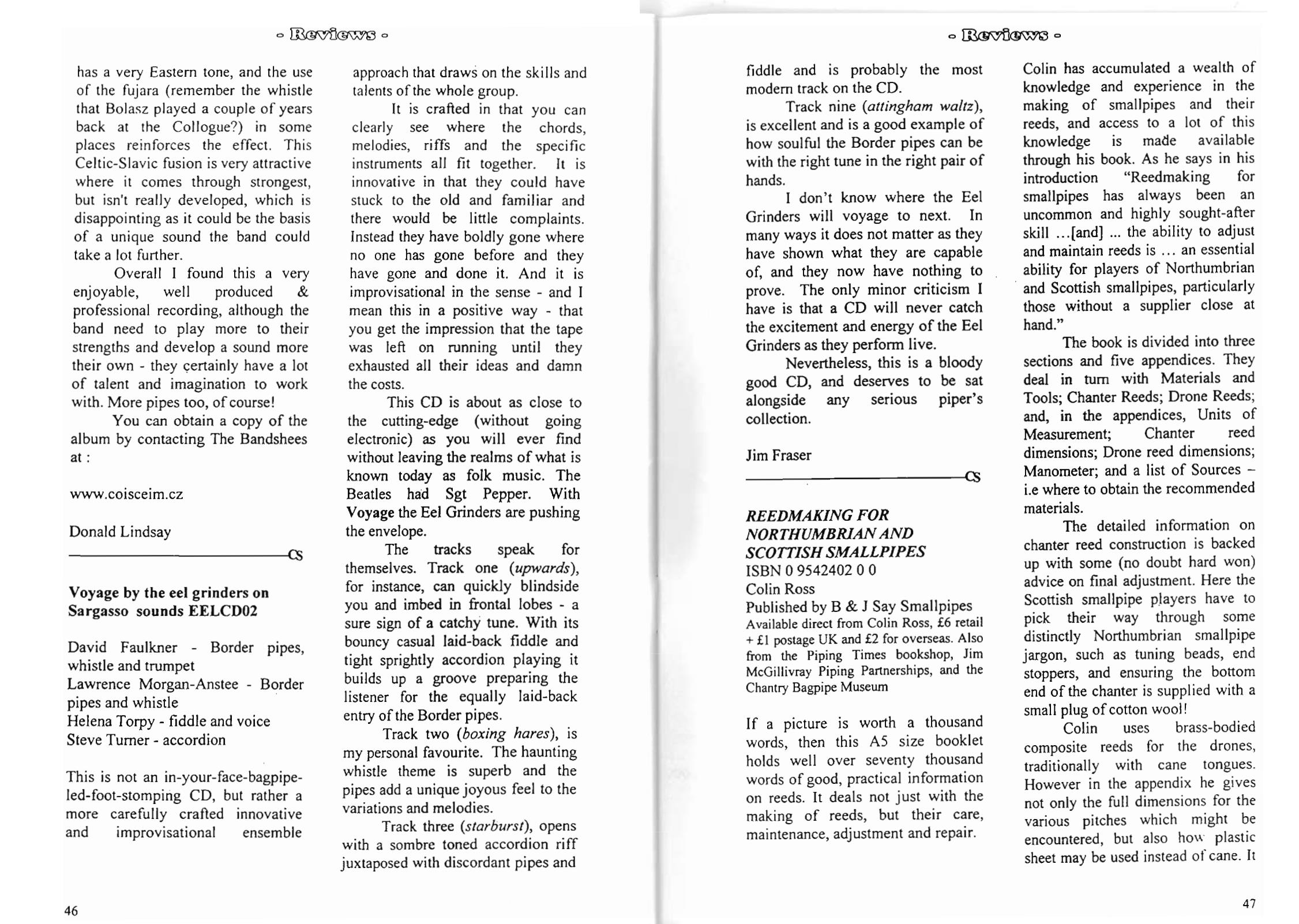Review: reedmaking for Northumbrian and Scottish Smallpipe


Reedmaking for Northumbrian and Scottish Smallpipes
ISBN 0 9542402 0 0
Colin Ross
Published by B & J Say Smallpipes
Available direct from Colin Ross, £6 retail + £1 postage UK and £2 for overseas. Also
from the Piping Times bookshop, Jim McGillivray Piping Partnerships, and the Chantry Bagpipe Museum.
If a picture is worth a thousand words, then this A5 size booklet holds well over seventy thousand words of good, practical information on reeds. It deals not just with the making of reeds, but their care, maintenance, adjustment and repair.
Colin has accumulated a wealth of knowledge and experience in the making of smallpipes and their reeds, and access to a lot of this knowledge is made available through his book. As he says in his introduction “Reedmaking for smallpipes has always been an uncommon and highly sought-after skill ...[and] ... the ability to adjust and maintain reeds is ... an essential ability for players of Northumbrian and Scottish smallpipes, particularly those without a supplier close at hand.”
The book is divided into three sections and five appendices. They deal in turn with Materi- als and Tools; Chanter Reeds; Drone Reeds; and, in the appendices, Units of Measurement; Chanter reed dimensions; Drone reed dimensions; Manometer; and a list of Sources -i.e where to obtain the recommended materials.
The detailed information on chanter reed construction is backed up with some (no doubt hard won) advice on final adjustment. Here the Scottish smallpipe players have to pick their way through some distinctly Northumbrian smallpipe jargon, such as tuning beads, end stoppers, and ensuring the bottom end of the chanter is supplied with a small plug of cotton wool!
Colin uses brass-bodied composite reeds for the drones, traditionally with cane tongues. However in the appendix he gives not only the full dimensions for the various pitches which might be encountered, but also how plastic sheet may be used instead of cane. It wasn’t en- tirely clear, though, whether the reed dimensions for drones tuned to a fifth represented the baritone or alto version.
It is always good value writing a review for this kind of book, for it means having to read through each section in detail and so discover items that a more casual approach might miss. For instance in the instructions for final adjustment of the chanter reed I came across the term “bag neck resonance”, a complaint which may be remedied by putting plastic foam in the top of the chanter stock or, more seriously, replacing the bag. And the simple ap- proach of testing the pitch of the reed when out of the chanter by using a tin whistle to sound C# is, in my financial situation, greatly preferable to buying a sophisticated electronic tuning meter.
I found the book particularly well laid out and clear, once I had got used to every sub- section and appendix being labelled with the same group of capital letters. Some sixty pho- tographs are provided which well illustrate the points made in the text. Clear line drawings add to, and further clarify, these half-tones. However the mix of imperial and metric meas- urements irritated me a little until I found Colin’s explanation and a conversion table in the appendix. And my own (now well thumbed) copy started to come apart at the staple, but I’m assured that Barry and Julia Say will be using heavier grade staples in future editions (their publishing business prints quite small batches at a time so that such matters may eas- ily be put right).
Even if the smallpipe player never reckons on having to make his own reeds, this book will still be of tremendous value. It gives a very good insight as to just what makes a reed tick (or screech!), and some very good practical advice on how to correct that screech and gen- erally make the playing easier.
Jock Agnew
